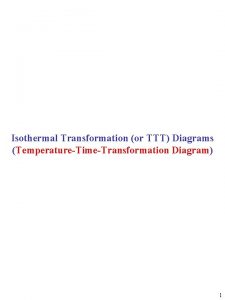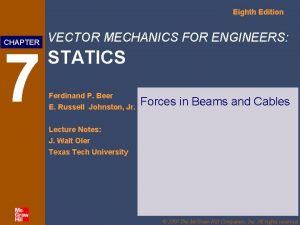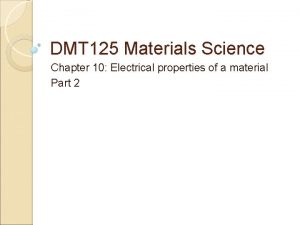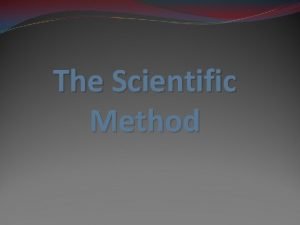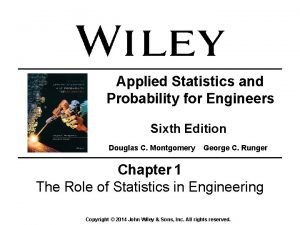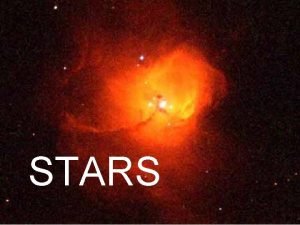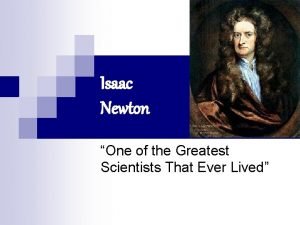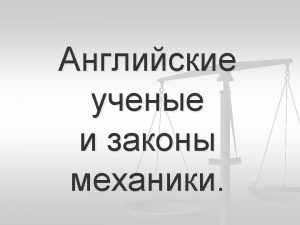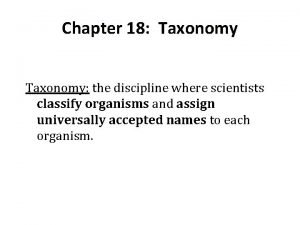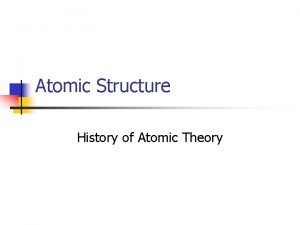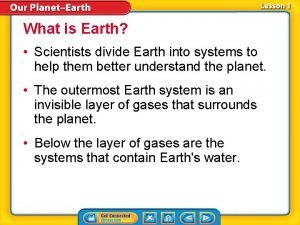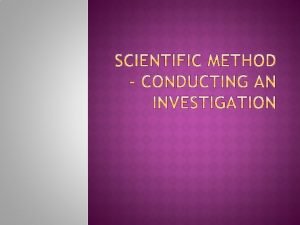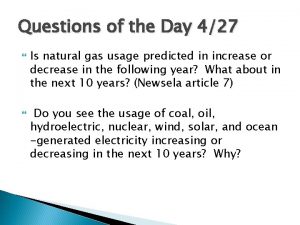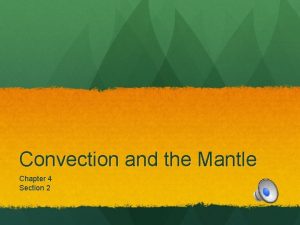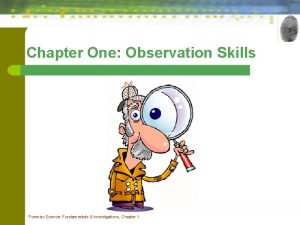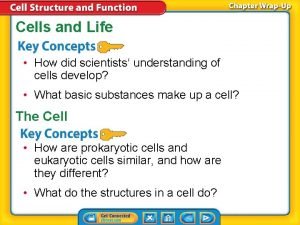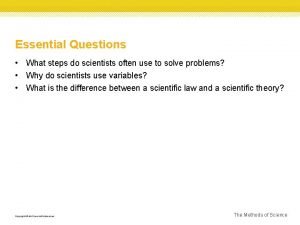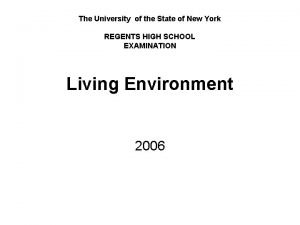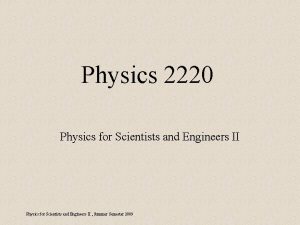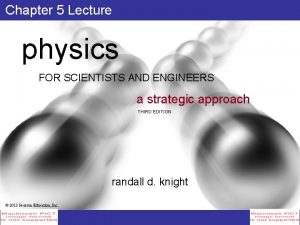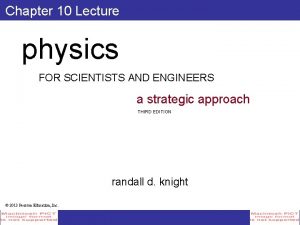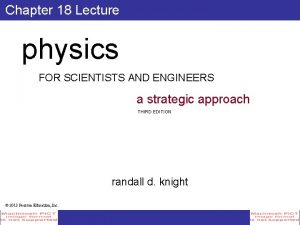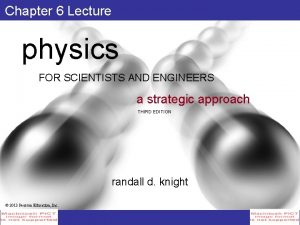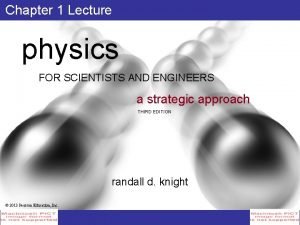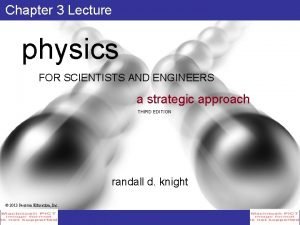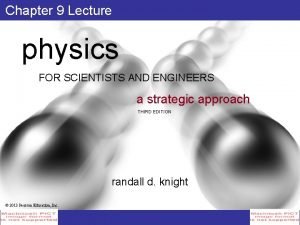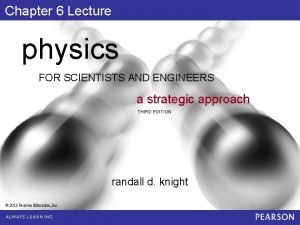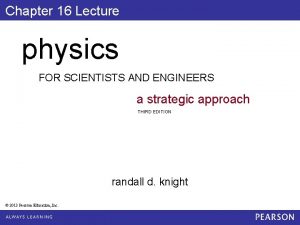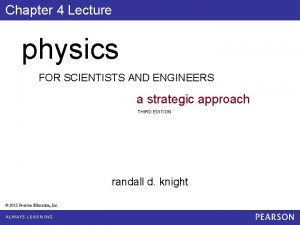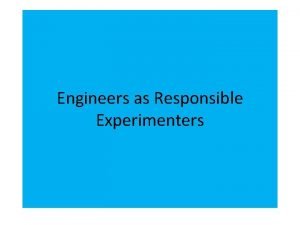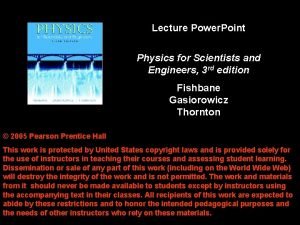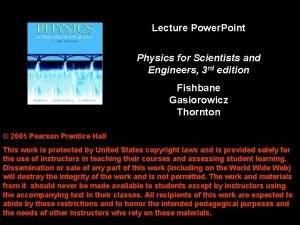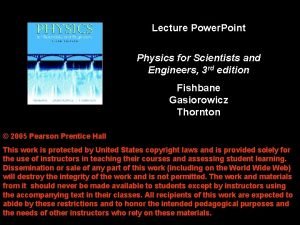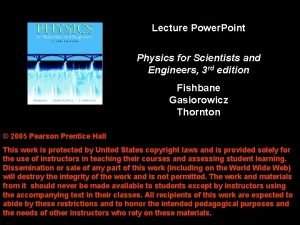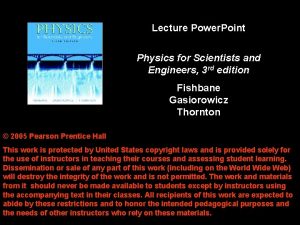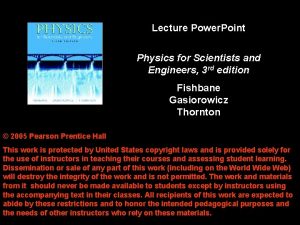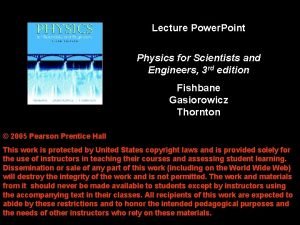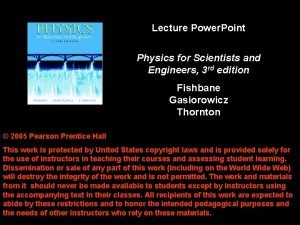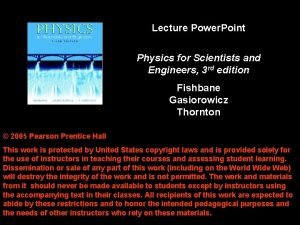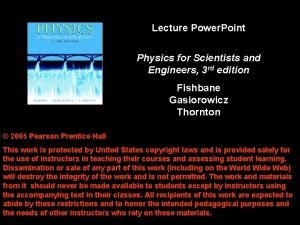Chapter 11 Lecture physics FOR SCIENTISTS AND ENGINEERS


















































































































- Slides: 114

Chapter 11 Lecture physics FOR SCIENTISTS AND ENGINEERS a strategic approach THIRD EDITION randall d. knight © 2013 Pearson Education, Inc.

Chapter 11 Work Chapter Goal: To develop a more complete understanding of energy and its conservation. © 2013 Pearson Education, Inc. Slide 11 -2

Chapter 11 Preview © 2013 Pearson Education, Inc. Slide 11 -3

Chapter 11 Preview © 2013 Pearson Education, Inc. Slide 11 -3

Chapter 11 Preview © 2013 Pearson Education, Inc. Slide 11 -5

Chapter 11 Preview © 2013 Pearson Education, Inc. Slide 11 -6

Chapter 11 Preview © 2013 Pearson Education, Inc. Slide 11 -7

Chapter 11 Preview © 2013 Pearson Education, Inc. Slide 11 -8

Chapter 11 Reading Quiz © 2013 Pearson Education, Inc. Slide 11 -9

Reading Question 11. 1 The statement K = W is called the A. Law of conservation of energy. B. Work-kinetic energy theorem. C. Kinetic energy equation. D. Weight-kinetic energy theorem. © 2013 Pearson Education, Inc. Slide 11 -10

Reading Question 11. 1 The statement K = W is called the A. Law of conservation of energy. B. Work-kinetic energy theorem. C. Kinetic energy equation. D. Weight-kinetic energy theorem. © 2013 Pearson Education, Inc. Slide 11 -11

Reading Question 11. 2 The transfer of energy to a system by the application of a force is called A. Dot product. B. Power. C. Work. D. Watt. E. Energy transformations. © 2013 Pearson Education, Inc. Slide 11 -12

Reading Question 11. 2 The transfer of energy to a system by the application of a force is called A. Dot product. B. Power. C. Work. D. Watt. E. Energy transformations. © 2013 Pearson Education, Inc. Slide 11 -13

Reading Question 11. 3 A vector has magnitude C. Then the dot product of the vector with itself, is A. 0. B. C/2. C. C. D. 2 C. E. C 2. © 2013 Pearson Education, Inc. Slide 11 -14

Reading Question 11. 3 A vector has magnitude C. Then the dot product of the vector with itself, is A. 0. B. C/2. C. C. D. 2 C. E. C 2. © 2013 Pearson Education, Inc. Slide 11 -15

Reading Question 11. 4 The work done by a dissipative force like friction, Wdiss, is A. Always zero. B. Always positive. C. Always negative. © 2013 Pearson Education, Inc. Slide 11 -16

Reading Question 11. 4 The work done by a dissipative force like friction, Wdiss, is A. Always zero. B. Always positive. C. Always negative. © 2013 Pearson Education, Inc. Slide 11 -17

Reading Question 11. 5 Light bulbs are typically rated in terms of their watts. The watt W is a measure of A. The change in the bulb’s potential energy. B. The energy consumed. C. The force exerted on the bulb holder. D. The power dissipated. © 2013 Pearson Education, Inc. Slide 11 -18

Reading Question 11. 5 Light bulbs are typically rated in terms of their watts. The watt W is a measure of A. The change in the bulb’s potential energy. B. The energy consumed. C. The force exerted on the bulb holder. D. The power dissipated. © 2013 Pearson Education, Inc. Slide 11 -19

Chapter 11 Content, Examples, and Quick. Check Questions © 2013 Pearson Education, Inc. Slide 11 -20

The Basic Energy Model W > 0: The environment does work on the system and the system’s energy increases. W < 0: The system does work on the environment and the system’s energy decreases. © 2013 Pearson Education, Inc. Slide 11 -21

The Basic Energy Model § The energy of a system is a sum of its kinetic energy K, its potential energy U, and its thermal energy Eth. § The change in system energy is: 1. Energy can be transferred to or from a system by doing work W on the system. This process changes the energy of the system: � Esys = W. 2. Energy can be transformed within the system among K, U, and Eth. These processes don’t change the energy of the system: � Esys = 0. © 2013 Pearson Education, Inc. Slide 11 -22

Quick. Check 11. 1 A skier is gliding down a slope at a constant speed. What energy transformation is taking place? A. K Ug B. Ug K C. Eth K D. Ug Eth E. K Eth © 2013 Pearson Education, Inc. Slide 11 -23

Quick. Check 11. 1 A skier is gliding down a slope at a constant speed. What energy transformation is taking place? A. K Ug B. Ug K C. Eth K D. Ug Eth E. K Eth © 2013 Pearson Education, Inc. Slide 11 -24

Work and Kinetic Energy § The word “work” has a very specific meaning in physics. § Work is energy transferred to or from a body or system by the application of force. § This pitcher is increasing the ball’s kinetic energy by doing work on it. © 2013 Pearson Education, Inc. Slide 11 -25

Work and Kinetic Energy § Consider a force acting on a particle which moves along the s-axis. § The force component Fs causes the particle to speed up or slow down, transferring energy to or from the particle. § The force does work on the particle: § The units of work are N m, where 1 N m = 1 kg m 2/s 2 = 1 J. © 2013 Pearson Education, Inc. Slide 11 -26

The Work-Kinetic Energy Theorem § The net force is the vector sum of all the forces acting on a particle. § The net work is the sum Wnet = Wi, where Wi is the work done by each force. § The net work done on a particle causes the particle’s kinetic energy to change. © 2013 Pearson Education, Inc. Slide 11 -27

An Analogy with the Impulse-Momentum Theorem § The impulse-momentum theorem is: § The work-kinetic energy theorem is: § Impulse and work are both the area under a force graph, but it’s very important to know what the horizontal axis is! © 2013 Pearson Education, Inc. Slide 11 -28

Quick. Check 11. 2 A tow rope pulls a skier up the slope at constant speed. What energy transfer (or transfers) is taking place? A. W Ug B. W K C. W Eth D. Both A and B. E. Both A and C. © 2013 Pearson Education, Inc. Slide 11 -29

Quick. Check 11. 2 A tow rope pulls a skier up the slope at constant speed. What energy transfer (or transfers) is taking place? A. W Ug B. W K C. W Eth D. Both A and B. E. Both A and C. © 2013 Pearson Education, Inc. Slide 11 -30

Work Done by a Constant Force § A force acts with a constant strength and in a constant direction as a particle moves along a straight line through a displacement. § The work done by this force is: § Here is the angle © 2013 Pearson Education, Inc. makes relative to . Slide 11 -31

Example 11. 1 Pulling a Suitcase © 2013 Pearson Education, Inc. Slide 11 -32

Example 11. 1 Pulling a Suitcase © 2013 Pearson Education, Inc. Slide 11 -33

Quick. Check 11. 3 A crane lowers a girder into place at constant speed. Consider the work Wg done by gravity and the work WT done by the tension in the cable. Which is true? A. B. Wg > 0 and WT > 0 Wg > 0 and WT < 0 C. Wg < 0 and WT > 0 D. Wg < 0 and WT < 0 E. Wg = 0 and WT = 0 © 2013 Pearson Education, Inc. Slide 11 -34

Quick. Check 11. 3 A crane lowers a girder into place at constant speed. Consider the work Wg done by gravity and the work WT done by the tension in the cable. Which is true? A. Wg > 0 and WT > 0 B. Wg > 0 and WT < 0 C. Wg < 0 and WT > 0 D. Wg < 0 and WT < 0 E. Wg = 0 and WT = 0 © 2013 Pearson Education, Inc. The downward force of gravity is in the direction of motion positive work. The upward tension is in the direction opposite the motion negative work. Slide 11 -35

Tactics: Calculating the Work Done by a Constant Force © 2013 Pearson Education, Inc. Slide 11 -36

Tactics: Calculating the Work Done by a Constant Force © 2013 Pearson Education, Inc. Slide 11 -37

Tactics: Calculating the Work Done by a Constant Force © 2013 Pearson Education, Inc. Slide 11 -38

Quick. Check 11. 4 Robert pushes the box to the left at constant speed. In doing so, Robert does ______ work on the box. A. positive B. negative C. zero © 2013 Pearson Education, Inc. Slide 11 -39

Quick. Check 11. 4 Robert pushes the box to the left at constant speed. In doing so, Robert does ______ work on the box. A. positive B. negative C. zero Force is in the direction of displacement positive work © 2013 Pearson Education, Inc. Slide 11 -40

Quick. Check 11. 5 A constant force pushes a particle through a displacement. In which of these three cases does the force do negative work? D. Both A and B. E. Both A and C. © 2013 Pearson Education, Inc. Slide 11 -41

Quick. Check 11. 5 A constant force pushes a particle through a displacement. In which of these three cases does the force do negative work? D. Both A and B. E. Both A and C. © 2013 Pearson Education, Inc. Slide 11 -42

Example 11. 2 Work During a Rocket Launch © 2013 Pearson Education, Inc. Slide 11 -43

Example 11. 2 Work During a Rocket Launch © 2013 Pearson Education, Inc. Slide 11 -44

Example 11. 2 Work During a Rocket Launch © 2013 Pearson Education, Inc. Slide 11 -45

Example 11. 2 Work During a Rocket Launch © 2013 Pearson Education, Inc. Slide 11 -46

Quick. Check 11. 6 Which force below does the most work? All three displacements are the same. A. B. C. D. The 10 N force. The 8 N force The 6 N force. They all do the same work. © 2013 Pearson Education, Inc. sin 60 = 0. 87 cos 60 = 0. 50 Slide 11 -47

Quick. Check 11. 6 Which force below does the most work? All three displacements are the same. A. The 10 N force. B. The 8 N force C. The 6 N force. D. They all do the same work. © 2013 Pearson Education, Inc. sin 60 = 0. 87 cos 60 = 0. 50 Slide 11 -48

Quick. Check 11. 7 A light plastic cart and a heavy steel cart are both pushed with the same force for a distance of 1. 0 m, starting from rest. After the force is removed, the kinetic energy of the light plastic cart is ____ that of the heavy steel cart. A. B. C. D. greater than equal to less than Can’t say. It depends on how big the force is. © 2013 Pearson Education, Inc. Slide 11 -49

Quick. Check 11. 7 A light plastic cart and a heavy steel cart are both pushed with the same force for a distance of 1. 0 m, starting from rest. After the force is removed, the kinetic energy of the light plastic cart is ____ that of the heavy steel cart. A. B. C. D. greater than Same force, same distance same work done equal to Same work change of kinetic energy less than Can’t say. It depends on how big the force is. © 2013 Pearson Education, Inc. Slide 11 -50

Force Perpendicular to the Direction of Motion § The figure shows a particle moving in uniform circular motion. § At every point in the motion, Fs, the component of the force parallel to the instantaneous displacement, is zero. § The particle’s speed, and hence its kinetic energy, doesn’t change, so W = K = 0. § A force everywhere perpendicular to the motion does no work. © 2013 Pearson Education, Inc. Slide 11 -51

Quick. Check 11. 8 A car on a level road turns a quarter circle ccw. You learned in Chapter 8 that static friction causes the centripetal acceleration. The work done by static friction is _____. A. positive B. negative C. zero © 2013 Pearson Education, Inc. Slide 11 -52

Quick. Check 11. 8 A car on a level road turns a quarter circle ccw. You learned in Chapter 8 that static friction causes the centripetal acceleration. The work done by static friction is _____. A. positive B. negative C. zero © 2013 Pearson Education, Inc. Slide 11 -53

The Dot Product of Two Vectors § The figure shows two vectors, and , with angle between them. § The dot product of is defined as: and § The dot product is also called the scalar product, because the value is a scalar. © 2013 Pearson Education, Inc. Slide 11 -54

The Dot Product of Two Vectors § The dot product © 2013 Pearson Education, Inc. as ranges from 0 to 180. Slide 11 -55

Example 11. 3 Calculating a Dot Product © 2013 Pearson Education, Inc. Slide 11 -56

The Dot Product Using Components If and , the dot product is the sum of the products of the components: © 2013 Pearson Education, Inc. Slide 11 -57

Example 11. 4 Calculating a Dot Product Using Components © 2013 Pearson Education, Inc. Slide 11 -58

Work Done by a Constant Force § A force acts with a constant strength and in a constant direction as a particle moves along a straight line through a displacement. § The work done by this force is: © 2013 Pearson Education, Inc. Slide 11 -59

Example 11. 5 Calculating Work Using the Dot Product © 2013 Pearson Education, Inc. Slide 11 -60

Example 11. 5 Calculating Work Using the Dot Product © 2013 Pearson Education, Inc. Slide 11 -61

The Work Done by a Variable Force To calculate the work done on an object by a force that either changes in magnitude or direction as the object moves, we use the following: We must evaluate the integral either geometrically, by finding the area under the curve, or by actually doing the integration. © 2013 Pearson Education, Inc. Slide 11 -62

Example 11. 6 Using Work to Find the Speed of a Car © 2013 Pearson Education, Inc. Slide 11 -63

Example 11. 6 Using Work to Find the Speed of a Car © 2013 Pearson Education, Inc. Slide 11 -64

Example 11. 6 Using Work to Find the Speed of a Car © 2013 Pearson Education, Inc. Slide 11 -65

Example 11. 6 Using Work to Find the Speed of a Car © 2013 Pearson Education, Inc. Slide 11 -66

Conservative Forces § The figure shows a particle that can move from A to B along either path 1 or path 2 while a force is exerted on it. § If there is a potential energy associated with the force, this is a conservative force. § The work done by as the particle moves from A to B is independent of the path followed. © 2013 Pearson Education, Inc. Slide 11 -67

Nonconservative Forces § The figure is a bird’s-eye view of two particles sliding across a surface. § The friction does negative work: Wfric = kmg s. § The work done by friction depends on s, the distance traveled. § This is not independent of the path followed. § A force for which the work is not independent of the path is called a nonconservative force. © 2013 Pearson Education, Inc. Slide 11 -68

Mechanical Energy § Consider a system of objects interacting via both conservative forces and nonconservative forces. § The change in mechanical energy of the system is equal to the work done by the nonconservative forces: § Mechanical energy isn’t always conserved. § As the space shuttle lands, mechanical energy is being transformed into thermal energy. © 2013 Pearson Education, Inc. Slide 11 -69

Example 11. 8 Using Work and Potential Energy © 2013 Pearson Education, Inc. Slide 11 -70

Example 11. 8 Using Work and Potential Energy © 2013 Pearson Education, Inc. Slide 11 -71

Example 11. 8 Using Work and Potential Energy © 2013 Pearson Education, Inc. Slide 11 -72

Finding Force from Potential Energy § The figure shows an object moving through a small displacement s while being acted on by a conservative force. § The work done over this displacement is: § Because is a conservative force, the object’s potential energy changes by U = −W = −FsΔs over this displacement, so that: © 2013 Pearson Education, Inc. Slide 11 -73

Finding Force from Potential Energy § In the limit s 0, we find that the force at position s is: § The force on the object is the negative of the derivative of the potential energy with respect to position. © 2013 Pearson Education, Inc. Slide 11 -74

Finding Force from Potential Energy § Figure (a) shows the potential-energy diagram for an object at height y. § The force on the object is (FG)y = mg. § Figure (b) shows the corresponding F-versus-y graph. § At each point, the value of F is equal to the negative of the slope of the U-versus-y graph. © 2013 Pearson Education, Inc. Slide 11 -75

Finding Force from Potential Energy § Figure (a) is a more general potential energy diagram. § Figure (b) is the corresponding F-versus-x graph. § Where the slope of U is negative, the force is positive. § Where the slope of U is positive, the force is negative. § At the equilibrium points, the force is zero. © 2013 Pearson Education, Inc. Slide 11 -76

Quick. Check 11. 9 A particle moves along the x -axis with the potential energy shown. At x = 4 m, the x-component of the force on the particle is A. – 4 N. B. – 2 N. C. 0 N. D. 2 N. E. 4 N © 2013 Pearson Education, Inc. Slide 11 -77

Quick. Check 11. 9 A particle moves along the x -axis with the potential energy shown. At x = 4 m, the x-component of the force on the particle is A. – 4 N. B. – 2 N. C. 0 N. D. 2 N. E. 4 N. © 2013 Pearson Education, Inc. Slide 11 -78

Thermal Energy § Figure (a) shows a mass M moving with velocity with macroscopic kinetic energy Kmacro = ½ Mvobj 2. § Figure (b) is a microphysics view of the same object. § The total kinetic energy of all the atoms is Kmicro. § The total potential energy of all the atoms is Umicro. § The thermal energy of the system is: © 2013 Pearson Education, Inc. Slide 11 -79

Dissipative Forces As two objects slide against each other, atomic interactions at the boundary transform the kinetic energy Kmacro into thermal energy in both objects. K Eth Kinetic friction is a dissipative force. © 2013 Pearson Education, Inc. Slide 11 -80

Dissipative Forces § The figure shows a box being pulled at a constant speed across a horizontal surface with friction. § Both the surface and the box are getting warmer as it slides. § Dissipative forces always increase thermal energy; they never decrease it. © 2013 Pearson Education, Inc. Slide 11 -81

Example 11. 9 Calculating the Increase in Thermal Energy © 2013 Pearson Education, Inc. Slide 11 -82

Conservation of Energy For a system with both internal interaction forces and external forces, the energy equation is: © 2013 Pearson Education, Inc. Slide 11 -83

Conservation of Energy © 2013 Pearson Education, Inc. Slide 11 -84

The Basic Energy Model For a system with both internal interaction forces and external forces, Esys, the total energy of the system, changes only if external forces transfer energy in or out of the system. © 2013 Pearson Education, Inc. Slide 11 -85

The Basic Energy Model When a system is isolated, Esys, the total energy of the system, is constant. © 2013 Pearson Education, Inc. Slide 11 -86

Energy Bar Charts We may express the conservation of energy concept as an energy equation. We may also represent this equation graphically with an energy bar chart. © 2013 Pearson Education, Inc. Slide 11 -87

Quick. Check 11. 10 How much work is done by the environment in the process represented by the energy bar chart? A. – 2 J B. – 1 J C. 0 J D. 1 J E. 2 J © 2013 Pearson Education, Inc. Slide 11 -88

Quick. Check 11. 10 How much work is done by the environment in the process represented by the energy bar chart? A. – 2 J B. – 1 J C. 0 J D. 1 J E. 2 J © 2013 Pearson Education, Inc. The system started with 5 J but ends with 4 J. 1 J must have been transferred from the system to the environment as work. Slide 11 -89

Problem-Solving Strategy: Solving Energy Problems © 2013 Pearson Education, Inc. Slide 11 -90

Problem-Solving Strategy: Solving Energy Problems © 2013 Pearson Education, Inc. Slide 11 -91

Example 11. 10 Energy Bar Chart I © 2013 Pearson Education, Inc. Slide 11 -92

Example 11. 10 Energy Bar Chart I © 2013 Pearson Education, Inc. Slide 11 -93

Example 11. 11 Energy Bar Chart Il © 2013 Pearson Education, Inc. Slide 11 -94

Example 11. 11 Energy Bar Chart Il © 2013 Pearson Education, Inc. Slide 11 -95

Example 11. 12 Energy Bar Chart Ill © 2013 Pearson Education, Inc. Slide 11 -96

Example 11. 12 Energy Bar Chart Ill © 2013 Pearson Education, Inc. Slide 11 -97

Power § The rate at which energy is transferred or transformed is called the power P. § The SI unit of power is the watt, which is defined as: Highly trained athletes have a tremendous power output. 1 watt = 1 W = 1 J/s § The English unit of power is the horsepower, hp. 1 hp = 746 W © 2013 Pearson Education, Inc. Slide 11 -98

Example 11. 13 Choosing a Motor © 2013 Pearson Education, Inc. Slide 11 -99

Example 11. 13 Choosing a Motor © 2013 Pearson Education, Inc. Slide 11 -100

Examples of Power © 2013 Pearson Education, Inc. Slide 11 -101

Power § When energy is transferred by a force doing work, power is the rate of doing work: P = d. W/dt. § If the particle moves at velocity while acted on by force , the power delivered to the particle is: © 2013 Pearson Education, Inc. Slide 11 -102

Quick. Check 11. 11 Four students run up the stairs in the time shown. Which student has the largest power output? © 2013 Pearson Education, Inc. Slide 11 -103

Quick. Check 11. 11 Four students run up the stairs in the time shown. Which student has the largest power output? © 2013 Pearson Education, Inc. Slide 11 -104

Example 11. 14 Power Output of a Motor © 2013 Pearson Education, Inc. Slide 11 -105

Example 11. 14 Power Output of a Motor © 2013 Pearson Education, Inc. Slide 11 -106

Chapter 11 Summary Slides © 2013 Pearson Education, Inc. Slide 11 -107

General Principles © 2013 Pearson Education, Inc. Slide 11 -108

General Principles © 2013 Pearson Education, Inc. Slide 11 -109

General Principles © 2013 Pearson Education, Inc. Slide 11 -110

Important Concepts © 2013 Pearson Education, Inc. Slide 11 -111

Important Concepts © 2013 Pearson Education, Inc. Slide 11 -112

Important Concepts © 2013 Pearson Education, Inc. Slide 11 -113

Important Concepts © 2013 Pearson Education, Inc. Slide 11 -114
 01:640:244 lecture notes - lecture 15: plat, idah, farad
01:640:244 lecture notes - lecture 15: plat, idah, farad Physics 111 lecture notes
Physics 111 lecture notes What is a harmonic wave in physics
What is a harmonic wave in physics Phy101 lecture 1
Phy101 lecture 1 Physics 101 lecture notes pdf
Physics 101 lecture notes pdf Waves 2 physics notes
Waves 2 physics notes Atmospheric physics lecture notes
Atmospheric physics lecture notes Introduction to materials science for engineers chapter 10
Introduction to materials science for engineers chapter 10 Vector mechanics for engineers
Vector mechanics for engineers Introduction to materials science for engineers chapter 10
Introduction to materials science for engineers chapter 10 Sometimes scientists make a mistake or
Sometimes scientists make a mistake or Diagrams tables and graphs are used by scientists mainly to
Diagrams tables and graphs are used by scientists mainly to Why does it happen
Why does it happen University physics with modern physics fifteenth edition
University physics with modern physics fifteenth edition Ib physics ia samples
Ib physics ia samples Fspos vägledning för kontinuitetshantering
Fspos vägledning för kontinuitetshantering Novell typiska drag
Novell typiska drag Tack för att ni lyssnade bild
Tack för att ni lyssnade bild Ekologiskt fotavtryck
Ekologiskt fotavtryck Varför kallas perioden 1918-1939 för mellankrigstiden
Varför kallas perioden 1918-1939 för mellankrigstiden En lathund för arbete med kontinuitetshantering
En lathund för arbete med kontinuitetshantering Personalliggare bygg undantag
Personalliggare bygg undantag Tidbok
Tidbok A gastrica
A gastrica Förklara densitet för barn
Förklara densitet för barn Datorkunskap för nybörjare
Datorkunskap för nybörjare Stig kerman
Stig kerman Debatt artikel mall
Debatt artikel mall Autokratiskt ledarskap
Autokratiskt ledarskap Nyckelkompetenser för livslångt lärande
Nyckelkompetenser för livslångt lärande Påbyggnader för flakfordon
Påbyggnader för flakfordon Kraft per area
Kraft per area Offentlig förvaltning
Offentlig förvaltning Kyssande vind analys
Kyssande vind analys Presentera för publik crossboss
Presentera för publik crossboss Teckenspråk minoritetsspråk argument
Teckenspråk minoritetsspråk argument Vem räknas som jude
Vem räknas som jude Klassificeringsstruktur för kommunala verksamheter
Klassificeringsstruktur för kommunala verksamheter Epiteltyper
Epiteltyper Bästa kameran för astrofoto
Bästa kameran för astrofoto Centrum för kunskap och säkerhet
Centrum för kunskap och säkerhet Lågenergihus nyproduktion
Lågenergihus nyproduktion Mat för unga idrottare
Mat för unga idrottare Verktyg för automatisering av utbetalningar
Verktyg för automatisering av utbetalningar Rutin för avvikelsehantering
Rutin för avvikelsehantering Smärtskolan kunskap för livet
Smärtskolan kunskap för livet Ministerstyre för och nackdelar
Ministerstyre för och nackdelar Tack för att ni har lyssnat
Tack för att ni har lyssnat Referatmarkering
Referatmarkering Redogör för vad psykologi är
Redogör för vad psykologi är Stål för stötfångarsystem
Stål för stötfångarsystem Atmosfr
Atmosfr Borra hål för knoppar
Borra hål för knoppar Vilken grundregel finns det för tronföljden i sverige?
Vilken grundregel finns det för tronföljden i sverige? R formel
R formel Tack för att ni har lyssnat
Tack för att ni har lyssnat Steg för steg rita
Steg för steg rita Verksamhetsanalys exempel
Verksamhetsanalys exempel Tobinskatten för och nackdelar
Tobinskatten för och nackdelar Blomman för dagen drog
Blomman för dagen drog Modell för handledningsprocess
Modell för handledningsprocess Egg för emanuel
Egg för emanuel Elektronik för barn
Elektronik för barn Antika plagg
Antika plagg Strategi för svensk viltförvaltning
Strategi för svensk viltförvaltning Kung dog 1611
Kung dog 1611 Indikation för kejsarsnitt på moderns önskan
Indikation för kejsarsnitt på moderns önskan Sju för caesar
Sju för caesar Tack för att ni lyssnade
Tack för att ni lyssnade Vilket tal pekar pilen på
Vilket tal pekar pilen på Bra rim texter
Bra rim texter Inköpsprocessen steg för steg
Inköpsprocessen steg för steg Rådet för byggkompetens
Rådet för byggkompetens Ledarskapsteorier
Ledarskapsteorier Slyngexcision
Slyngexcision Myndigheten för delaktighet
Myndigheten för delaktighet Frgar
Frgar Sju principer för tillitsbaserad styrning
Sju principer för tillitsbaserad styrning Läkarutlåtande för livränta
Läkarutlåtande för livränta Karttecken brun triangel
Karttecken brun triangel Lek med former i förskolan
Lek med former i förskolan Vishnuismen
Vishnuismen Mitos steg
Mitos steg Bris för vuxna
Bris för vuxna Bamse för de yngsta
Bamse för de yngsta Applied statistics and probability for engineers 6th
Applied statistics and probability for engineers 6th Avant-garde engineers & consultants fzc
Avant-garde engineers & consultants fzc Scientists recently discovered that rocks collected
Scientists recently discovered that rocks collected How do scientists classify stars?
How do scientists classify stars? What did isaac newton's mom want him to be
What did isaac newton's mom want him to be Newton one of the greatest scientists
Newton one of the greatest scientists At the periphery of a hurricane the air is ____
At the periphery of a hurricane the air is ____ Famous german scientists
Famous german scientists Famous english scientists
Famous english scientists Why do scientists classify organisms?
Why do scientists classify organisms? Democritus atomic model
Democritus atomic model Food scientists measure food energy in:
Food scientists measure food energy in: Sig fig examples
Sig fig examples Isaac newton one of the greatest scientists
Isaac newton one of the greatest scientists How scientists work
How scientists work Famous food scientists
Famous food scientists Famous romanian scientists
Famous romanian scientists Where can scientists obtain stem cells? *
Where can scientists obtain stem cells? * Scientists divide the atmosphere into how many layers?
Scientists divide the atmosphere into how many layers? What important attitudes do successful scientists possess
What important attitudes do successful scientists possess Hispanic american scientists
Hispanic american scientists Union of concerned scientists
Union of concerned scientists Scientists think that convection currents flow in earth's *
Scientists think that convection currents flow in earth's * Observation definition forensics
Observation definition forensics How did scientists understanding of cells develop
How did scientists understanding of cells develop Scientists have to
Scientists have to What steps do scientists often use to solve problems?
What steps do scientists often use to solve problems? Why do scientists classify organisms?
Why do scientists classify organisms? Scientists discover how develop brains
Scientists discover how develop brains Scientist hypothesize that cabbage broccoli cauliflower
Scientist hypothesize that cabbage broccoli cauliflower







